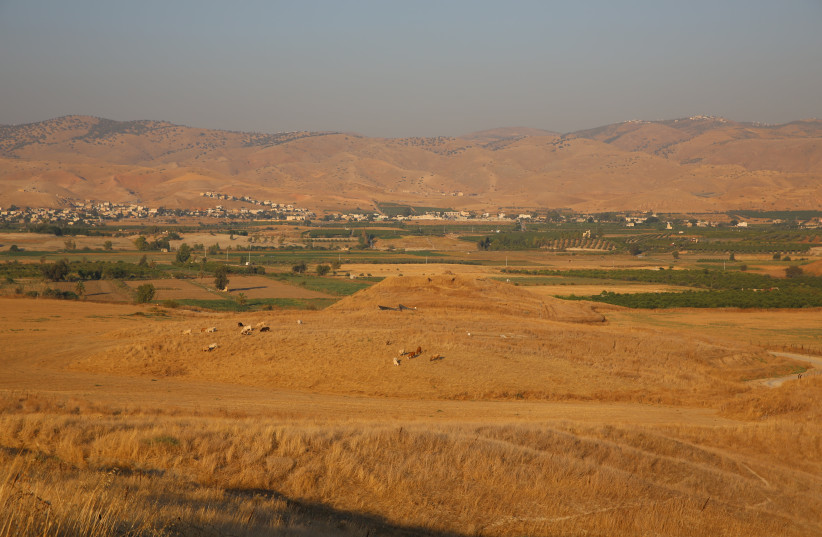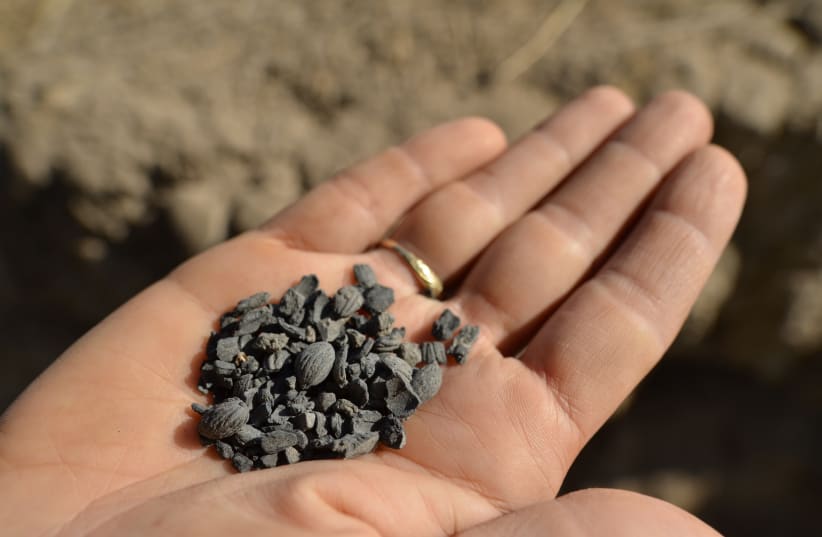The earliest evidence of the use of cotton fibers in the ancient Near East and among the oldest in the world from nearly 7,000 years ago have been found in an archaeological dig at Tel Tsaf southeast of Beit She’an in the Jordan Valley. Probably reaching the large village that existed from the time of the Chalcolithic period, the cotton fibers probably arrived at Tel Tsaf from the Indus Valley region that is present-day Pakistan thousands of kilometers away.
The cotton fibers found at Tel Tsaf predate the evidence found so far by several hundred years and they probably arrived at Tel Tsaf from the Indus Valley region, present-day Pakistan, from a distance of thousands of kilometers.
Tel Tsaf flourished during the transition period between the small agricultural societies and the large urban cities of the country, said Prof. Danny Rosenberg of the University of Haifa’s Zinman Institute of Archaeology.
“Until today, we knew that the inhabitants of the site had trade relations with distant regions such as Egypt, Iraq and Anatolia, and now the circle of trade expands even further to the Indus Valley, where cotton was probably first domesticated. What is interesting about this early evidence of a connection with such a distant region is that it comes from fibers – microscopic pieces of ancient threads. We assume that these cotton fibers, found together with wool fibers and plant fibers, arrived at the site as part of fabrics or clothing, that is, from ancient textiles,” he added.
Clothes do not stand the test of time
Humans probably produced textile products already tens of thousands of years ago using certain plants such as flax for the fabric fibers they created. However, since fabrics and many other organic materials tend to break down quickly in conditions other than dry conditions or inorganic conditions, in a significant part of the sites in the Mediterranean climate areas it is rare to find them.

The main evidence comes to us from late texts and paintings or from the tools that were apparently used to produce the fibers and textile products.
Recently, however, researchers have begun to use new methods for locating organic findings, including microscopic and chemical tests that are able not only to locate evidence of plants but also to identify whether it is a fiber that was woven on purpose and what the plant was from which it was woven.
“Part of the issue is that this type of evidence was almost never looked for in ancient sites, and many times they don’t even try to find this type of find,” Rosenberg continued.
He added, “the main challenge, as in DNA research and organic materials research that we do at Tel Tsaf is to prevent modern contamination of the sample. In the case of fiber and textile research, the challenge is to neutralize the entry of modern fibers into the sample, since cotton fibers can be found in most clothing items today.”
TEL TSAF, which flourished 7,200 years ago in the valley of the springs not far from Kibbutz Tirat Zvi, was a very large settlement where probably hundreds of people lived.
The settlement prospered for about 500 years, and one of the great mysteries is why the settlement stopped at the site, without any signs of distress or lack of resources. This is one of the topics on which the researchers plan to invest a lot of effort in the coming years, Rosenberg added.
He said, “we are still trying to understand why in such an important period of time in human history – when the small agricultural villages began to expand and grow, the social structure began to become complex in what would be the basis for the growth of the important state cities of the region and significant technological and culinary developments that it ceased to exist.”
The last years of excavation have already revealed evidence of important technological leaps that took place at Tel Tsaf and economic ties that its inhabitants had with very distant regions, which were an integral part of the formation of the new socio-economic order, such as the appearance of metal, the production of beer for social and ceremonial consumption, specialization in the creation of uniform stone bricks, hoarding of food on a large scale and more.
That is why the researchers, led by Prof. Li Liu from Stanford University in California and Rosenberg from the University of Haifa, decided to try to find the same stealthy evidence of the use and production of textiles.
In the pioneering research conducted simultaneously at the two universities, samples taken from fragments of ancient pottery found in residential layers on the site and from the land next to them were examined and the promising results are already being used as a basis for various follow-up studies.
Most of the evidence found in the current study at Tel Tsaf was of flax fibers, but the researchers also found evidence of fibers that were probably made from other plants, including wool – apparently from sheep.
“The accepted concept so far is that the local flax was the plant from which textiles were made in the ancient Near East until the appearance of the wool industry thousands of years later. Our new evidence, which shows that some of the fibers were dyed, together with studies we have conducted in recent years on tools used to produce textiles such as those for spinning, challenge this concept. This indicates more developed technological capabilities than those we knew,” said Rosenberg.
BUT AN even more surprising find was fibers from cotton, which is not a native plant in the ancient Near East. According to what is known to researchers, today’s cotton has four origins – two in South and Central America, one in the Indus Valley, where there is evidence of the use of cotton as early as 6,000 years ago, and the last one, in Africa, where there is evidence of the use of cotton beginning in the first century BCE.
Ancient DNA studies have shown that cotton was domesticated independently and separately in these areas, and although it is not possible to determine whether the cotton at Tel Tsaf represents domesticated plants, the researchers said the early dating of the location indicates with great probability that the cotton fibers came from the Indus Valley region and not from any source in Africa or America.
The earliest evidence collected so far of cotton fibers in our region was dated to a few hundred years later from the late Chalcolithic period and the Early Bronze Age (approximately 5,000-6,500 years ago) and it comes from the Dhuweila archaeological site in eastern Jordan.
In contrast to the exact dating at Tel Tsaf, the finds from Dhuweila do not yet have a precise date, and in any case, they are later than those we found at Tel Tsaf by several hundred years, at the very least.
They join a series of unique finds from Tel Tsaf, which testify to its importance as an ancient trading center, in addition to being a rich site whose economy was based on increased agricultural produce in an area that even today is characterized by many water sources and extremely high temperatures, especially in the summer.
